Step 3 - Planning
Step 3, of our 4-step guide, covers planning your grassland management.
Missed Step 1 -2? Revisit these essentials grassland management stages.

Missed Step 1 -2? Revisit these essentials grassland management stages.
RESEED 15% OF YOUR GRASSLAND EVERY YEAR
Planning to reseed 15% of your grassland every year will ensure that, within six years, you’ll have the latest modern grass varieties available across your farm.
When deciding what grass to sow, think about the options and do your research. Don’t just rely on what you know. Grass genetics have changed a lot in the last twenty years - with our grasses showing an average year-on-year improvement in yield of 0.5%. It is unlikely that you’d rely on genetics from a quarter of a century ago for your livestock - so why do the same with grass?
When choosing a grass seed mixture/product, think about what you want the crop to achieve:
| Grass mixture types | Typical duration |
| Annual | Less than 1 year |
| Italian Ryegrass | 1 - 2 years |
| Short Rotation | 2-4 years |
| Long Rotation | 5+ years |
| Perennial | 8+ years |
WHAT TO SOW
DIPLOID V TETRAPLOID
If you don’t know much about grass, deciding between a diploid and tetraploid can be difficult/ confusing.
Below we’ve detailed some differences to help making the decision-making process easier.
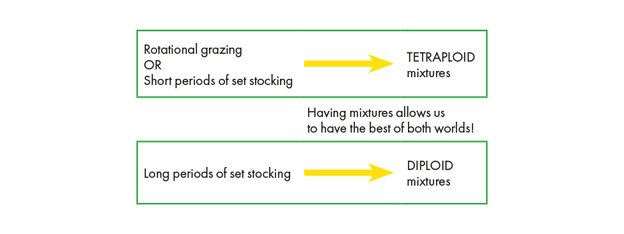
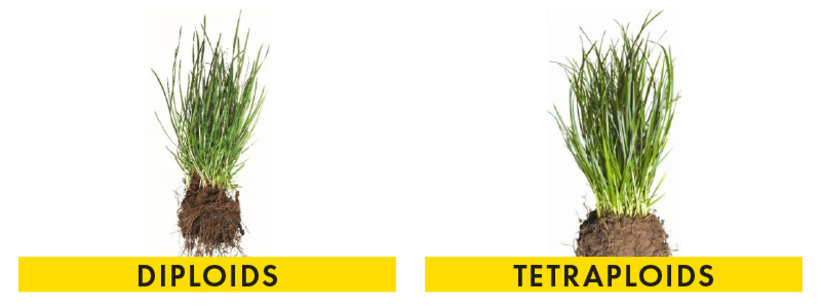
DIPLOIDS:
TETRAPLOIDS:
If you are still undecided, you could go for a mixture - giving you the best of both worlds. Whatever route you choose, make sure the seed you pick is able to meet your needs. There can be a big difference in the quality of mixture ranges available. Try to choose products or mixtures that contain grasses which feature on national recommended lists. This will make sure you get a modern, well-developed variety, that will perform as it should.
Once you’ve picked your grass seed mixture, the next step is to create a grassland management plan and decide when would be the best time to take a field out of rotation to sow. Grass seed can be sown at anytime from April to September - ideally when the soil is moist or when rain is forecast and the weather is frost free. If possible keep animals off as long as possible to enable establishment and manage the swards effectively - see Step 4 for other top tips.
There are over 10,000 species of grass in the world. Naturally we can’t list them all here, so we’ve concentrated on a selection of key productive species, which you can find detailed here. Of course, if you need more grass advice specific to your needs and situation, get in touch.
DESCRIPTION
Dark green, densely or loosely tufted. Folded shoot and leaves.
FLOWERING HEAD
Flattened spike with the spikelets arranged alternately on opposite side of the stem. The spikelets are stalk-less with the narrow, rounded face fitting against the stem.
LEAF BLADE
Ribbed on upper surface, smooth and shiny underside
AURICLES & LIGULE
Auricles are usually well developed, up to 1/12 of an inch (2mm) long, or are sometimes lacking.
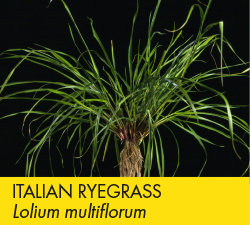
DESCRIPTION
A brighter green than perennials, densely or loosely tufted.
Similar to ryegrass but leaves rolled into the bud and not folded.
Tends to be larger, stouter and more densely tufted than ryegrass.
LEAF BLADE
Ribbed on upper surface, smooth below.
Red at base.
AURICLES & LIGULE
Narrow, spreading, prominent when old.
Small, 2mm. Blunt

DESCRIPTION
The hybrid ryegrass is a cross between the Italian and perennial forms of ryegrass and shares characteristics of both.
The dominant parent determines how the variety performs in the field.
Characterised as a rapid growing variety lasting from 1-5 years or longer depending on summer conditions and endophyte status.

DESCRIPTION
An annual ryegrass. Recent breeding advances in the development of quality Westerwold varieties mean it is now a serious option for UK farmers.
Westerwold annual ryegrass is an ecotype of Italian ryegrass selected for earliness, and is not botanically different from Italian ryegrass and its characteristics are also similar.

DESCRIPTION
Our modern Timothys are bred to have softer leaves and higher palatability. The coarse tufted grass with many varieties covering a range of growth habits. Generally light green or greyish-green. Flattened shoot.
FLOWERING HEAD
Dense cylindrical spike giving the alternative common name. Spikelets are small, single flowered and tightly packed; green, often tinted pink or white.
LEAF BLADE
Flattended Broad leaves. Smooth, double rib down the centre. Boat shaped at tip.
AURICLES & LIGULE
Small and spreading, minutely hairy.
Short, 2mm. Finely serrated
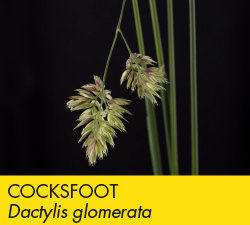
DESCRIPTION
Our modern Cocksfoots are bred to have softer leaves and higher palatability. Large, coarse-looking tufted grass often bluish-green in colour.
FLOWERING HEAD
One-sided, distinctive flower/feather like seed head. Spikelets are small flattened and condensed into oval shaped clusters.
LEAF BLADE
Dull leaf, flattened, wide and flat
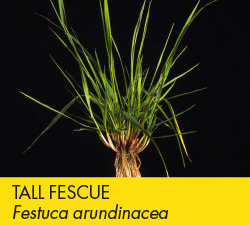
DESCRIPTION
Very tall tufted perennial forming dense tussocks. Tillers large and foliage coarse. Short bristles along edge of collar (visible with magnification).
LEAF BLADE
Broad green leaves, fringed auricle and strongly ribbed leaves, glossy lower surface.
Harsh to touch with fine silica teeth which can be felt.
AURICLES LIGULE
Small and spreading, minutely hairy.
Short, 2mm. Finely serrated
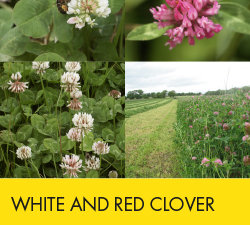
DESCRIPTION
Clover fixes nitrogen in the soil (figures of 170-220kg N/ha/ yr are achievable) - and is therefore a very valuable species in efficient grassland management.
WHITE CLOVER
(white flowers)
A perennial legume with round leaves and very long stalks. Key to its survival is its multi-branched creeping stem (stolon), which provides sites for new leaves, roots, and flowers.
RED CLOVER
(red flowers)
A short-lived perennial legume that typically lasts for two to four years. In contrast to white clover, it has oval leaves, an upright growth habit, and a strong deep tap root.
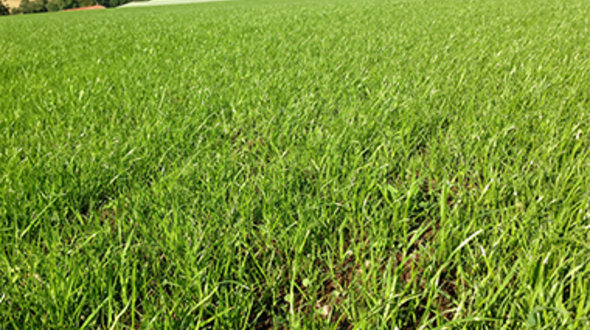
Once step 3 is complete move on to step 4, Establish.